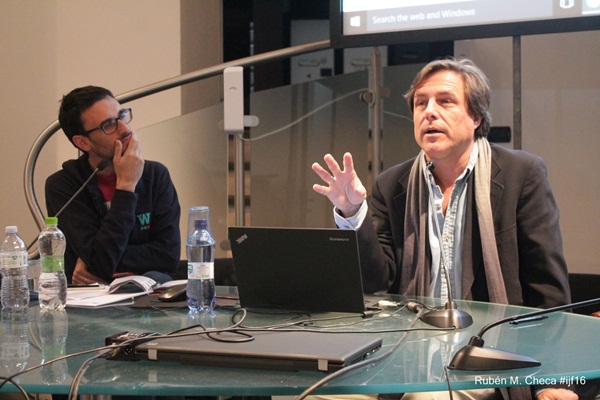
“The living room experience is going to change. Right now we have great flat screens, but after time it’ll be more like a virtual experience. There are new ways to tell stories in a more emotional way, so the living room will be a very different place in ten years,” said Jim Louderback, venture partner at Social Starts, during the panel discussion “The living room opportunity: video news consumption in the over-the-top age” at the International Journalism Festival.
Louderback talked about the expansion of video consumption with Adriano Farano, Co-founder and CEO at Watchup, who said that we are just at the beginning of a huge transformation: “And I think that journalists have all the skills and knowledge to take advantage of distribution,” Farano said. According to him, telling a good story is the core essential: creating well-produced content to make a good product.
“Probably, 90% of the households in the US subscribe to cable or satellite to get television,” said Farano to underline the huge amount of population now depending on over-the-top (OTT) consumption rather than set-top – so called due to the typical positioning of cable boxes on television sets of the past.
“Now, as people buy smart TVs that are essentially computers inside of televisions, these boxes are going away. There are new services [available],” weighted in Louderback.
To highlight the reasons behind this trend Farano and Louderback further examined the case of the United States. In the country there are about 100m pay-TV subscribers who spend an average $92 dollars on sports, entertainment and news, both local and national: out of the hundreds of channels available, people have a tendency to always go back to the same ones – no more than 10 or 11, usually. This propensity for habitual channel-watching has sparked within the audience the question: “Why should I keep paying so much money if there are so many other options that can come to me over the top?”
The panellists discussed the strategies their companies adopted in order to supply a new type of service that could attract and engage the public more than traditional types of video providers.
“When we started TechTv in 1998 – said Louderback – we did something revolutionary: we went to a company called US Robotics and we got 50,000 digital cameras that plugged in [our] computers, and webcams, and we gave these webcams to our audience. We were the first ones to put the audience on television.”
While the images looked “terrible” it gave the company the opportunity to establish a relationship with the public: as the Internet and the bandwidth got better, the opportunities to expand and improve engagement increased.
Farano also shared his experience in launching the streaming service Watchup: the main idea was to create a personalised newscast offering audiences access to a large amount of news videos from all over the world, and giving them the opportunity to select their sources of information. He then proceeded to analyse the changing trends in devices used to access the app. Starting off with iPads, the company soon moved to smartphones and, having witnessed its success during the first year, they began to tailor it to Amazon FireTv and gaming consoles: “When we talked to those [gaming] companies, they told us that most of the time spent by a gamer on the gaming console is spent [watching] video.”
Talking about the development of big media, Louderback discussed the one which according to him could soon become the next big thing of the digital age: “Virtual Reality allows to tell stories in a brand new way and it’s better than the flat TV in your home. Also, journalists can tell their stories in different ways.”
To support this thesis, Louderback presented a piece of 3D journalism by Chris Milk titled Clouds over Sidra: “It takes you in a way that nothing could do before: it’s the way to tell stories in a magnificent way. We can bring the audiences more and more into the stories,” Louderback said before moving to his conclusion.
As he pointed out, many companies – like car manufacturers, and liquor and cosmetic companies – have already begun to embark in experimentation with virtual reality. Analytics also could increasingly become an important tool within the field considering the multitude of data VR can calculate: heat maps could be interpreted to understand individual emotions, and journalists could use those information to better relate to interviewees: “Journalism is already competing with other types of content, and in the living room that competition is even more fierce than in places like Facebook, Google, etc. – said Farano – because somebody enters the living room and sits on his/her couch and you – as a journalistic organisation – are competing with other services for the attention of that person.”
“We, like journalists, have to be sure that the experience in the living room is designed for that type of audience. No one wants to sit on a couch and read a text article or spend a lot of time finding the right type of video content that they want to consume. Chances are these people are much more willing to have a type of information that comes to them,” concluded Farano.